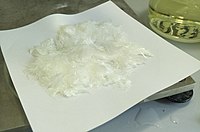
Photo from wikipedia
ABSTRACT Exploding bridgewire (EBW) detonators work by bursting a thin conducting wire as a result of a high voltage discharge. This process is known to produce a strong UV emission.… Click to show full abstract
ABSTRACT Exploding bridgewire (EBW) detonators work by bursting a thin conducting wire as a result of a high voltage discharge. This process is known to produce a strong UV emission. The roles of optical absorption, photochemistry, shock sensitivity, and impact sensitivity are assessed with respect to the relative roles each plays in the operation of an EBW detonator. The optical absorptivity and penetration depth have been measured using dilute polycrystalline samples of PETN, RDX, HMX, CL-20 and HNS in KBr between 190 and 1100 nm. The results show strong absorption at UV wavelengths with a gradual decline at longer ones. It is found that while strong UV absorption appears to be necessary, it is not sufficient to make an effective EBW detonator.
Journal Title: Journal of Energetic Materials
Year Published: 2020
Link to full text (if available)
Share on Social Media: Sign Up to like & get
recommendations!